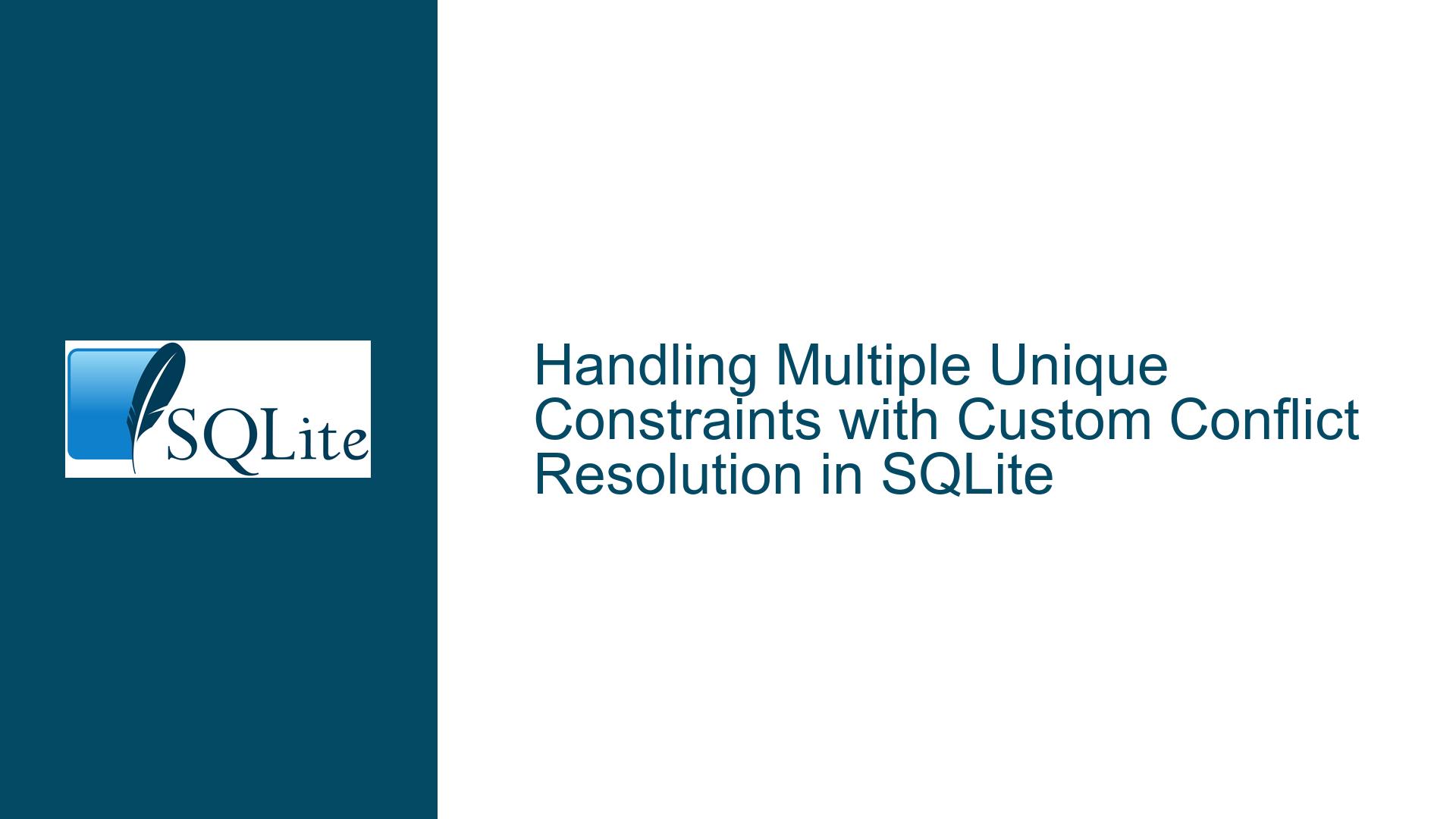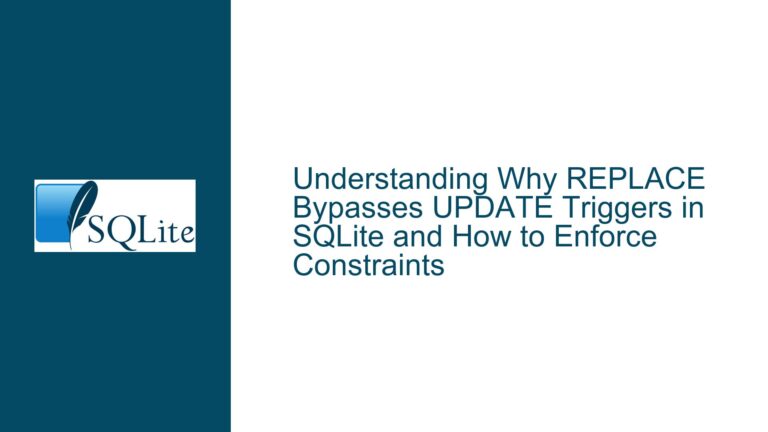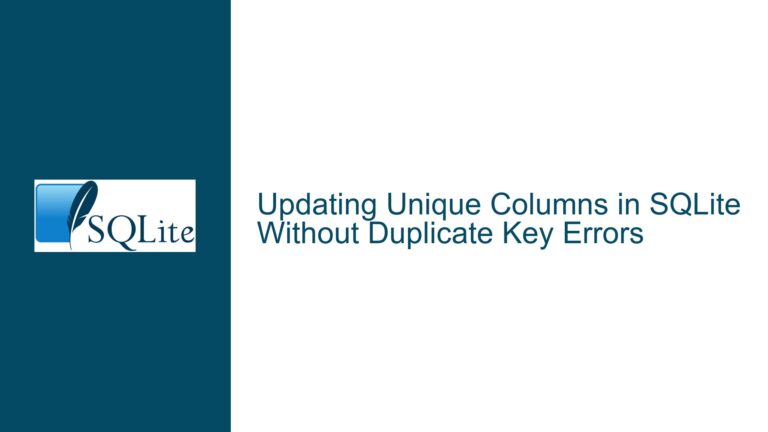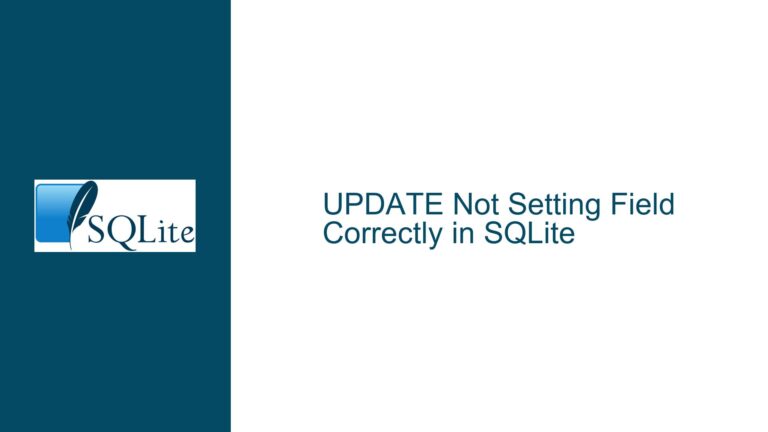Handling Multiple Unique Constraints with Custom Conflict Resolution in SQLite
SQLite’s ON CONFLICT Clause Limitations with Multiple Unique Constraints
SQLite’s ON CONFLICT clause is a powerful tool for handling constraint violations during INSERT operations. However, when a table has multiple unique constraints, the current implementation of ON CONFLICT does not allow for specifying different conflict resolution strategies for each unique constraint within a single INSERT statement. This limitation can lead to scenarios where developers need to handle conflicts on one unique constraint differently from conflicts on another unique constraint, but are unable to do so directly.
For example, consider a table t with two unique constraints on columns a and b:
CREATE TABLE t(
a UNIQUE,
b UNIQUE
);
If you attempt to insert a row where both a and b conflict with existing rows, SQLite will only allow you to specify a single conflict resolution strategy for the entire INSERT statement. This means that you cannot, for instance, choose to IGNORE a conflict on column a while FAILing on a conflict with column b in the same INSERT statement.
Interplay Between Unique Constraints and Conflict Resolution Strategies
The core issue arises from the way SQLite processes the ON CONFLICT clause. When an INSERT statement is executed, SQLite checks for conflicts against all unique constraints in the table. If a conflict is detected, the conflict resolution strategy specified in the ON CONFLICT clause is applied. However, this strategy is applied globally to the entire INSERT statement, not on a per-constraint basis.
For instance, consider the following INSERT statement:
INSERT OR IGNORE INTO t(a,b) VALUES (1,1);
If the value 1 already exists in column a, the IGNORE strategy will be applied, and the row will not be inserted. However, if the value 1 already exists in column b, the same IGNORE strategy will be applied, and the row will again not be inserted. There is no way to specify that conflicts on column a should be ignored, while conflicts on column b should cause the INSERT to fail.
This behavior is particularly problematic in scenarios where different unique constraints have different business logic implications. For example, a conflict on column a might be benign and can be safely ignored, while a conflict on column b might indicate a serious data integrity issue that should cause the INSERT to fail.
Implementing Custom Conflict Resolution with Conditional Logic and UPSERT
While SQLite’s current implementation of ON CONFLICT does not support per-constraint conflict resolution, there are workarounds that can achieve similar results. One approach is to use conditional logic in combination with the UPSERT feature introduced in SQLite 3.24.0. The UPSERT feature allows you to specify different actions to take when a conflict occurs on a specific unique constraint.
For example, consider the following table:
CREATE TABLE t(
a UNIQUE,
b UNIQUE
);
To achieve the desired behavior where conflicts on column a are ignored, but conflicts on column b cause the INSERT to fail, you can use the following approach:
Check for Conflicts Manually: Before performing the
INSERT, you can manually check for conflicts on the specific columns where you want to enforce different conflict resolution strategies. This can be done usingSELECTstatements withEXISTSclauses.Use Conditional Logic: Based on the results of the conflict checks, you can then decide whether to proceed with the
INSERTor to raise an error.Leverage UPSERT for Specific Conflicts: For conflicts that should be ignored, you can use the
ON CONFLICT DO NOTHINGclause. For conflicts that should cause theINSERTto fail, you can use theON CONFLICT DO FAILclause.
Here is an example of how this can be implemented:
-- Check for conflicts on column 'a'
SELECT EXISTS(SELECT 1 FROM t WHERE a = 1) AS conflict_a;
-- Check for conflicts on column 'b'
SELECT EXISTS(SELECT 1 FROM t WHERE b = 1) AS conflict_b;
-- If there is a conflict on column 'b', raise an error
-- Otherwise, proceed with the INSERT
INSERT INTO t(a, b)
VALUES (1, 1)
ON CONFLICT(a) DO NOTHING
ON CONFLICT(b) DO FAIL;
In this example, the SELECT EXISTS statements are used to check for conflicts on columns a and b. If a conflict is detected on column b, the INSERT statement will fail. If a conflict is detected on column a, the INSERT statement will proceed, but the conflict on column a will be ignored.
This approach allows you to implement custom conflict resolution strategies for each unique constraint, even though SQLite’s ON CONFLICT clause does not natively support per-constraint conflict resolution.
Future Enhancements and Best Practices
The SQLite development team has recognized the need for more flexible conflict resolution strategies and has indicated that future releases of SQLite may include enhancements to the ON CONFLICT clause. These enhancements could include the ability to specify multiple ON CONFLICT clauses, each with its own conflict resolution strategy, and the ability to use standard conflict resolution methods like ABORT, FAIL, IGNORE, and ROLLBACK within the ON CONFLICT clause.
Until these enhancements are available, developers can use the workarounds described above to achieve custom conflict resolution strategies. Additionally, it is important to follow best practices when designing database schemas and writing SQL queries to minimize the likelihood of conflicts and to ensure that conflicts are handled in a way that is consistent with the application’s business logic.
Some best practices include:
Careful Schema Design: When designing a database schema, carefully consider the unique constraints that are needed and how conflicts on those constraints should be handled. Avoid creating unnecessary unique constraints that could lead to conflicts.
Use Transactions: When performing multiple
INSERToperations that depend on each other, use transactions to ensure that all operations are completed successfully or that none are completed. This can help prevent partial updates that could lead to data integrity issues.Error Handling: Implement robust error handling in your application to handle conflicts and other errors that may occur during
INSERToperations. This can include logging errors, notifying users, and taking corrective actions as needed.Testing: Thoroughly test your database schema and SQL queries to ensure that conflicts are handled correctly and that the application behaves as expected in all scenarios.
By following these best practices and using the workarounds described above, you can effectively handle conflicts in SQLite even when dealing with multiple unique constraints and custom conflict resolution strategies.






